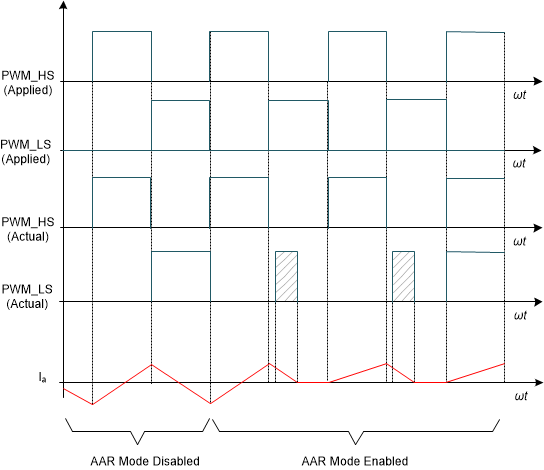JAJSPC5 December 2022 DRV8316C
PRODUCTION DATA
- 1 特長
- 2 アプリケーション
- 3 概要
- 4 Revision History
- 5 Device Comparison Table
- 6 Pin Configuration and Functions
- 7 Specifications
-
8 Detailed Description
- 8.1 Overview
- 8.2 Functional Block Diagram
- 8.3
Feature Description
- 8.3.1 Output Stage
- 8.3.2 Control Modes
- 8.3.3 Device Interface Modes
- 8.3.4 Step-Down Mixed-Mode Buck Regulator
- 8.3.5 AVDD Linear Voltage Regulator
- 8.3.6 Charge Pump
- 8.3.7 Slew Rate Control
- 8.3.8 Cross Conduction (Dead Time)
- 8.3.9 Propagation Delay
- 8.3.10 Pin Diagrams
- 8.3.11 Current Sense Amplifiers
- 8.3.12 Active Demagnetization
- 8.3.13 Cycle-by-Cycle Current Limit
- 8.3.14
Protections
- 8.3.14.1 VM Supply Undervoltage Lockout (NPOR)
- 8.3.14.2 AVDD Undervoltage Lockout (AVDD_UV)
- 8.3.14.3 BUCK Undervoltage Lockout (BUCK_UV)
- 8.3.14.4 VCP Charge Pump Undervoltage Lockout (CPUV)
- 8.3.14.5 Overvoltage Protection (OVP)
- 8.3.14.6 Overcurrent Protection (OCP)
- 8.3.14.7 Buck Overcurrent Protection
- 8.3.14.8 Thermal Warning (OTW)
- 8.3.14.9 Thermal Shutdown (OTS)
- 8.4 Device Functional Modes
- 8.5 SPI Communication
- 8.6 Register Map
- 9 Application and Implementation
- 10Power Supply Recommendations
- 11Layout
- 12Device and Documentation Support
- 13Mechanical, Packaging, and Orderable Information
8.3.12.2 Automatic Asynchronous Rectification Mode (AAR Mode)
Figure 8-35 shows the operation of AAR in PWM mode. As shown in this figure, a PWM is applied in a synchronous rectification to the high-side and low-side FETs. During the low-side FET conduction, for lower inductance motors, the current can decay to zero and becomes negative since low side FET is in on-state. This creates a negative torque on the BLDC motor operation. When AAR mode is enabled, the current during the decay is monitored and the low-side FET is turned off as soon as the current reaches near to zero. This saves the negative current building in the BLDC motor which results in better noise performance and better thermal management.
 Figure 8-35 AAR in PWM Mode
Figure 8-35 AAR in PWM Mode